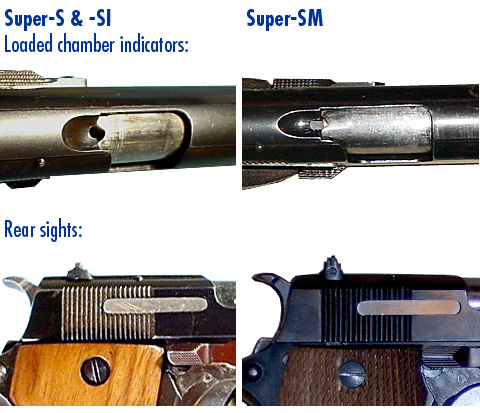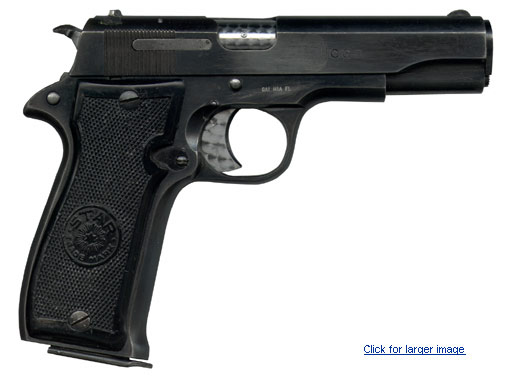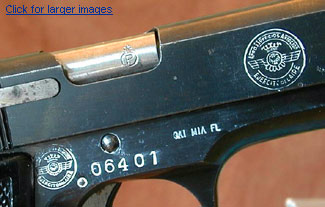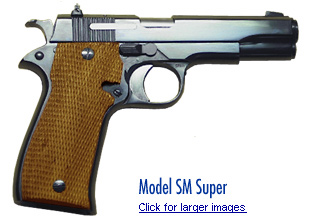Star Firearms — S-series pistols
The S series are all similar, compact, all steel locked-breech pistols chambered in .380 or .32 ACP. Practically every firearms manufacturer made pocket pistols in this approximate size range and these calibers, up through the 30's, many of them in Spain. A number of these were knockoffs of the Browning 1903, which Star — as well as dozens of other Eibar-region makers — made extensively.
Though the S is apparently just an extension of the pre-war pocket pistol, they are in fact scaled down versions of the full-sized Star pistols, complete with a short-recoil locked-breech. Whether derivitives of the A or B series (or the M or P sub-variants) is not entirely clear, but at the time of their introduction in 1940 B series pistols had been on the market for nearly a decade.
Throughout the series, both .32 ACP (7.65 mm) and .380 ACP (9 mm Browning Short or 9 mm Corto) versions have been made. In all cases, the base model is in .380, while an "I" suffix denotes a .32 caliber chambering. Most parts interchange between the two, but as the cases are different sizes, there is no way to simply switch out a few parts and change calibers. No other calibers, such as .22 LR, were made. The ultra-rare Super Target model (Super-SM) was not apparently made in .32
Manuals & Disassembly Instructions
I do not have manuals for every pistol shown on this site. However, in many cases there is a related manual. Partly to make the series relationships clearer, and partly to assist with speed and accuracy of updating, all manuals can be found in one place, the manuals page. All manuals available are provided as downloadable PDFs, or you may purchase a printed copy of the entire set of handgun manuals.
All Classic series pistols strip in the same way. Do not the significant differences between older swinging-link and later "Super" variations.
S-Series Pistols in Military Service
The S has been used by the police and armed forces of a number of countries, especially by troops who value space and weight the most, such as aviators. Unlike other military issue pistols, the model S seems to have never been produced in year-coded versions. The commerical, letter-coded variants were used for service instead.
I do not have anything like a comprehensive list, but know that certain units of World War II Luftwaffe aircrew were issued a model S of some sort. The Spanish Air Forces also issued them, and Marine pilots retained them in service up thru the early 1990s. Most model S pistols issued for service seem to have been stamped by the issuing organization. All those I have seen are on the right side of the slide, forward of the ejection port, as the Spanish Air Force seal is to the left.
Although I have seen several references to the Luftwaffe pistols being not Nazi proofed — and of this being a very unique thing in German service — recent troubles with identification of Model B (.08) pistols lead me to report it with a grain of salt. If you think you have a German issue model S, you might. I just have no way to tell right now.
Undocumented Sub-Variants & Parts-ordering Confusion
Anyone who sells Star model S parts has for years said that there are small, almost random variations in the internal dimensions of certain parts in the series. Places like the Numrich Gun Parts Corp. insist you directly measure the firing pin shaft and they will find one based on that size.
Based on my years of observing the difficulty most people seem to have with finding, reading and interpreting the model numbers from the bottom of Star pistols, I now have another opinion on this. I believe that the variations are documented, and are the model variants described below. Changes are the result of varying calibers, safety system upgrades and the like. As the guns are very common, and always remain almost identical-looking externally, they are all considered "model S," with differences.
Until someone with access to a large repository of model S weapons checks this out, its just a theory though. Keep doing whatever your parts supplier needs you to do when purchasing replacement parts.
Models S & SI
By the time the S series was introduced, in 1940, the basic series (A/B) had already undergone four major updates. For this reason, there are fewer unusual and early variants of the model S pistol. The basic versions, S and SI, are fully-realized designs, with arched backstraps and no apparent safety or manufacturing defects. This basic series remained in production until 1983, when the entire classic line was discontinued.
The model S pistols are identical to the larger A and B series, even to the degree that they all are shipped with the same manual (they even have tiny, removable barrel bushings!). Though the tipping barrel locked breech seems un-necessary, it allows the gun to be much lighter than most competing straight-blowback designs. The front sight remained a relatively useless half-circle throughout its life.
Four years after the introduction of the model S, a .32 caliber version was released, with the I suffix. This also remained in production until 1983. I find this to be somewhat odd for a European manufacturer. Among pocket pistols, .32 has been most popular in most of the world, inclund Europe, and .380 is more popular in the US. I have no idea what the reasoning was behind introducing the .380 version first.
Model SM
There may also have been a model SM. It is not listed in all sources, and never very clearly or well, so if it exists I have no idea when it was made and what features it definately incorporated. However, as I have seen several Super SM pistols, I can surmise it was mostly just a model S with slightly taller adjustable sights. There appears to be no such thing as a model "SIM" .32 caliber variant of this model.
Models SS & SIS
In 1957, in lockstep with the basic A/B series, an improved safety variant of both calibers was introduced. This version remained in production alongside the basic model S and SI until 1983. All safety variants are denoted with an S suffix (following the caliber suffix in the case of the .32 gun, the SIS).
These weapons should all have a drop safety as well as a magazine safety, that makes the gun incapable of firing when the magazine is removed.
Models Super-S, Super-SI & Super-SM
As with almost all of the classic-era Star pistols, a series of Super models were produced of the S series. These were also produced starting in 1948, when the A/B series began offering the their Super variants. They were manufactured alongside the basic and safety models, instead of replacing them, until the entire product line was replaced in 1983. Production of the Super-SM did not begin until 1971, and again did not replace any other variants, but simply added to the available options. There appears to be no such thing as a "Super-SIM" .32 caliber version of the Super-SM.
The swinging link on the previous, non-super, models was replaced with a Sig 210 (or modern-series Star) style closed cam path integral to the barrel. Related to this, a full-length guide rod with captive spring, and a quick takedown lever were added as well. All of these models have a magazine safety, but one different from the previous S variants. Minor changes were also made to the trigger system.

The Super-S and -SI both also added a sort of loaded chamber indicator, with a relief cut and hole through which can be viewed the rim of a loaded cartridge. The Super-SM added to this a lever, which could be felt to indicate if the gun was loaded in darkness.
All of the Super S series pistols retained quite small pocket-pistol sights. While the Super-S and -SI added a slight sight rib, the -SM also made the rear sight adjustable for drift with a small screw.
Most S-series Super pistols seem to be accurately labeled on the butt with the entire name, unlike other series which simply say "Super" more often than not. These should, therefore, be among the easiest of Star pistols to accurately identify.


